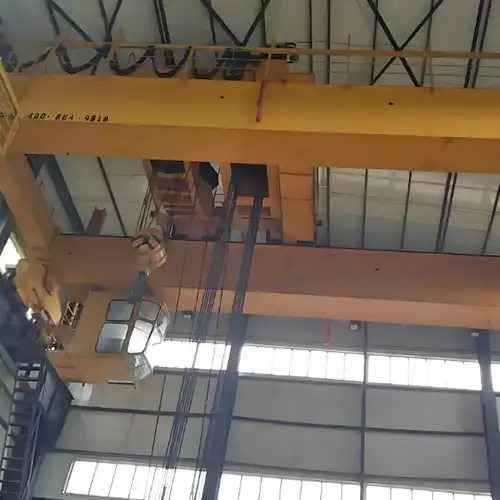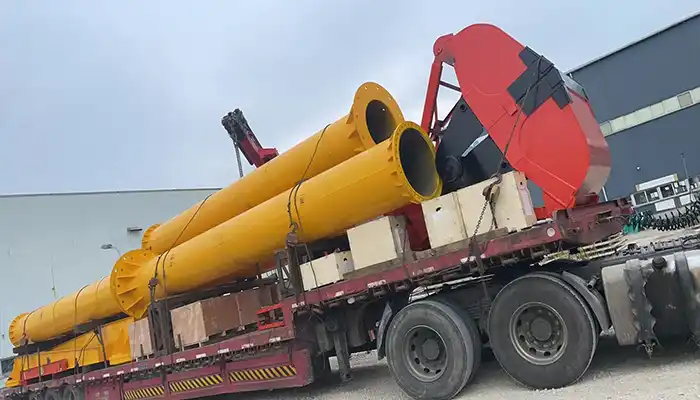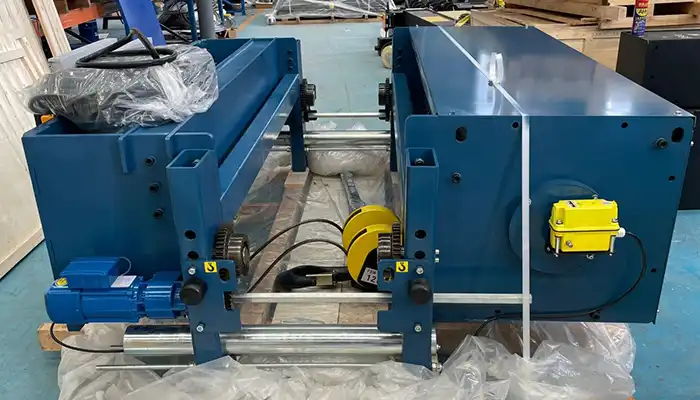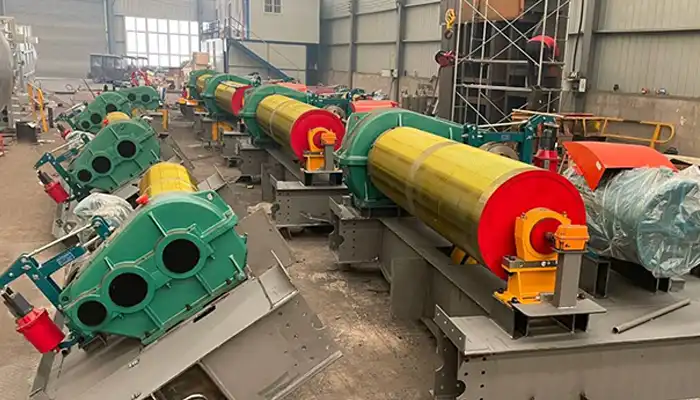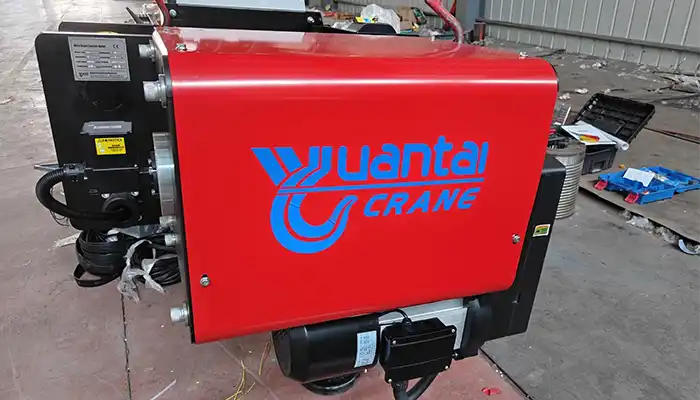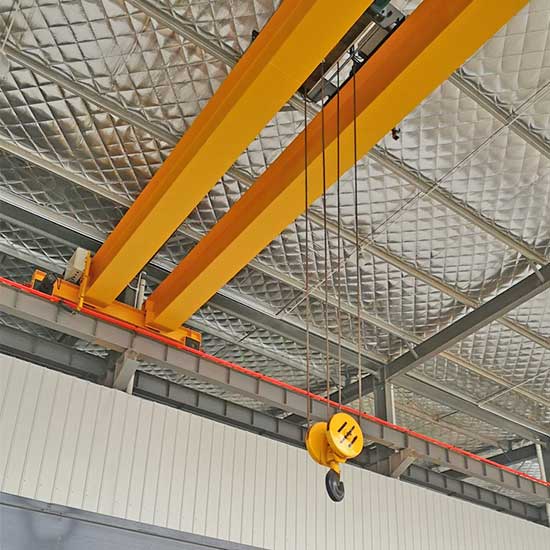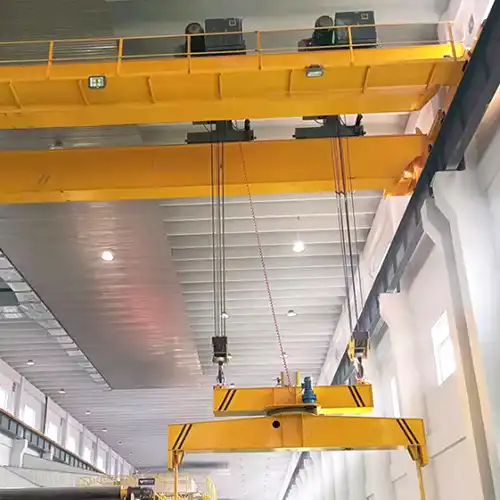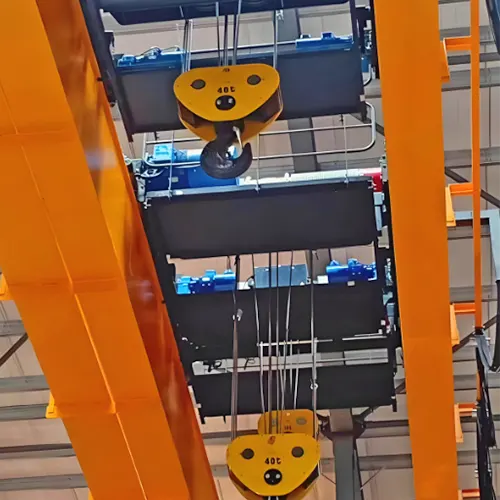Financing Options for a 40 ton Overhead Crane
Financing makes a 40 ton overhead crane affordable through leasing, loans & payment plans, easing upfront costs & improving cash flow.Get good price crane!
Category: Featured
Your Trusted 40 Ton Overhead Bridge Crane Manufacturer & Supplier
How Financing Options Can Make a 40 ton Overhead Crane Affordable for Your Business
A 40 ton overhead crane is a significant investment for many businesses. The cost of the crane, installation, and ongoing maintenance can be high, making it difficult for some companies to afford the upfront payment.
Making Crane Investments More Accessible
For businesses that need this equipment but can't pay for it all at once, financing offers a solution. With financing, you can spread out the costs and reduce the impact on your cash flow.
Purpose of This Guide
This guide will explore various financing options to help you afford a 40 ton overhead crane, including:
- Leasing options
- Loans
- Payment plans
By understanding these options, you can choose the best solution for your business and make a smart investment in the equipment that will improve your operations.
Cost of a 40 ton Overhead Crane
Breakdown of the Purchase Cost
A 40 ton overhead crane isn't just about the price of the equipment itself. The total cost includes several factors:
- Equipment Cost: This is the base price of the crane. Prices vary based on the model, brand, and specifications. A 40 ton crane can cost anywhere from tens of thousands to over a hundred thousand dollars, depending on these factors.
- Installation: You'll also need to factor in the cost of installation. This includes setting up the crane in your facility, including any required adjustments to the building structure.
- Additional Features: Many cranes come with optional features like remote controls, specialized hooks, or custom configurations. These features can increase the overall cost, but they may be necessary to meet specific business needs.
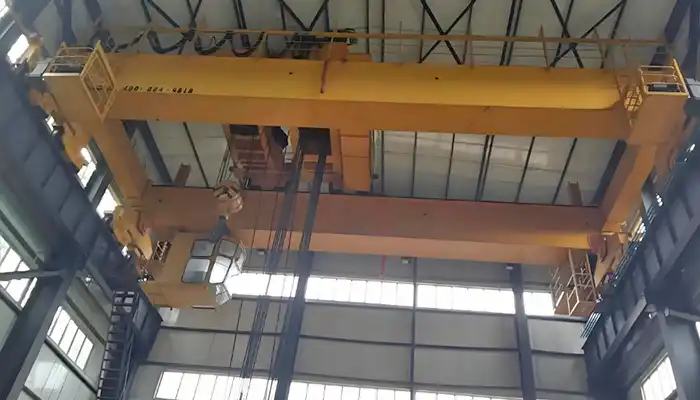
Ongoing Maintenance and Operational Costs
Once the crane is in operation, there are ongoing costs to keep it running smoothly:
- Maintenance: Regular maintenance is essential to keep the crane in good working condition. This includes inspections, lubrication, parts replacement, and any needed repairs.
- Operational Costs: These are the daily costs of running the crane, such as energy usage and any wear and tear that affects its performance. Over time, these costs can add up, so it’s important to include them in your financial plan.
Importance of Making a Long-Term Financial Plan
A 40 ton crane is a long-term investment, and it’s important to plan for both the purchase cost and ongoing expenses. Making a financial plan helps ensure that you can handle the costs without affecting your business’s cash flow.
When planning, consider:
- Depreciation: Cranes lose value over time. Understanding this can help with tax planning and future replacement decisions.
- Emergency Funds: Unexpected repairs or replacements may arise, so it’s a good idea to set aside funds for such situations.
By planning ahead, you can avoid financial strain and ensure that your crane remains a valuable asset to your business.
Financing Solutions Overview
Definition of Financing and Its Role in Capital-Heavy Investments
Financing is the process of obtaining the necessary funds to make a purchase or investment without needing to pay the full amount upfront. For capital-heavy equipment like a 40 ton overhead crane, financing helps businesses spread out the cost over time, making it more affordable.
In industries where large equipment is essential for operations, financing plays a key role. It allows businesses to acquire high-cost machinery without draining their cash reserves, ensuring they can still invest in other important areas, like growth or operational improvements.
Key Benefits of Financing for Overhead Cranes
- Improved Cash Flow: Financing lets you preserve your working capital, so you have more flexibility in your day-to-day operations. Instead of paying the full cost upfront, you make manageable payments, freeing up funds for other expenses.
- Reduced Upfront Costs: With financing, you avoid the large, lump-sum payment that can be difficult for businesses, especially small or growing companies. This can help reduce the immediate financial strain.
- Flexibility in Payments: Financing options come with various payment plans that can be tailored to fit your business's cash flow and budget. Whether you choose a lease, loan, or installment plan, you have the flexibility to select the option that works best for you.
Leasing a 40 ton Overhead Crane
Explanation of Leasing Options (Operating vs. Finance Leases)
Leasing allows businesses to use a 40 ton overhead crane without the need to purchase it outright. There are two main types of leases:
- Operating Lease: In this lease type, the business rents the crane for a set period. At the end of the lease, the business can return the crane, renew the lease, or upgrade to a newer model. This type is often used when businesses want to avoid long-term ownership and keep equipment up to date.
- Finance Lease: Also known as a capital lease, this option is more like a loan. The business leases the crane for a long term with the option to purchase the equipment at the end of the lease for a residual value. This is ideal for businesses that plan to use the crane for many years and want to eventually own it.
Pros of Leasing
- Lower Upfront Costs: Leasing typically requires a much smaller initial payment compared to buying. This makes it easier for businesses to manage their cash flow.
- Tax Benefits: Lease payments can often be deducted as business expenses, reducing taxable income and lowering tax liability.
- Flexibility at the End of the Lease Term: At the end of the lease, you can choose to return the crane, purchase it, or enter into a new lease. This provides flexibility as your business needs change.
When Leasing Is Ideal for Businesses
Leasing is a great option for businesses that:
- Need equipment but don’t have the capital to buy outright
- Prefer to upgrade equipment regularly
- Want to avoid maintenance and repair costs (for operating leases, the lessor often covers these)
- Prefer predictable expenses that fit into a budget without large upfront costs
Common Lease Structures
Leasing arrangements come in various structures, but here are some common terms:
- Monthly Payments: You’ll pay a fixed monthly amount throughout the lease period.
- Lease Periods: Lease terms can vary, but typically range from 3 to 7 years, depending on the crane and the lease type.
- Buyout Options: In a finance lease, the option to buy the crane at the end of the lease is common. The price is usually lower than the initial purchase price and is based on the crane's residual value.
Case Studies: Real-World Examples of Businesses Using Leasing
- Manufacturing Company: A manufacturing company in the automotive industry leased a 40 ton overhead crane for five years. The company benefited from the low initial payment, and at the end of the lease, they had the option to buy the crane for a reduced price or upgrade to a newer model to meet changing demands.
- Construction Firm: A construction company used an operating lease for a 40 ton crane for a large project. The company needed the crane for a short period and didn’t want to commit to a long-term investment. At the end of the lease term, they returned the crane, allowing them to allocate resources to other projects without the burden of ownership.
These examples show how leasing can be a practical and flexible solution for businesses of all sizes.
Loan Financing for Purchasing a 40 ton Overhead Crane
Overview of Loan Options
When it comes to purchasing a 40 ton overhead crane, businesses can choose from several loan options:
- Traditional Bank Loans: These are the most common loan types offered by commercial banks. They typically have competitive interest rates but may require a strong credit history and collateral.
- SBA Loans: Small Business Administration (SBA) loans are designed to help small businesses with lower interest rates and longer repayment terms. They are often easier to qualify for than traditional bank loans.
- Equipment Loans: Specifically designed for purchasing equipment, these loans use the crane itself as collateral. They tend to offer more favorable terms for businesses buying machinery but may require a larger down payment.
Loan Terms and Conditions
When applying for a loan to purchase a 40 ton crane, several key terms will affect your repayment plan:
- Interest Rates: The interest rate is the amount the lender charges for borrowing money. Rates can vary based on the type of loan and your business's creditworthiness.
- Repayment Schedules: Loan repayment schedules can be structured monthly, quarterly, or annually, depending on the lender and the loan terms. It’s essential to choose a repayment plan that aligns with your business’s cash flow.
- Collateral: For equipment loans, the crane itself may be used as collateral. If the loan is not repaid, the lender can take possession of the equipment. Traditional loans may require additional business assets as collateral.
Pros and Cons of Loans for Crane Purchase
Pros:
- Ownership: Loans allow businesses to own the crane outright after repayment, which is a long-term asset for the company.
- Fixed Payments: Many loans offer fixed monthly payments, making it easier for businesses to plan their cash flow.
- Tax Benefits: Interest on equipment loans may be deductible as a business expense, which can lower taxable income.
Cons:
- Debt Obligation: Loans increase a business’s debt load and may strain cash flow if not managed properly.
- Collateral Risk: In case of a default, the business risks losing the equipment or other assets used as collateral.
- Qualification Requirements: Businesses may need to meet certain credit and financial requirements to qualify for a loan.
Steps to Applying for a Loan and Qualifying Criteria
- Determine Your Loan Type: Decide whether a traditional loan, SBA loan, or equipment loan is best for your needs.
- Gather Financial Documents: Lenders will ask for detailed financial records, including tax returns, balance sheets, and proof of income.
- Check Credit Score: Lenders typically require a good credit score to qualify for loans with favorable terms.
- Submit Application: Fill out the loan application form and provide all necessary documentation.
- Wait for Approval: Lenders will assess your application, financial health, and business plan before making a decision. This process can take anywhere from a few days to several weeks.
Case Study: Business Benefiting from Loan Financing
A construction company in need of a 40 ton overhead crane for a large project turned to an equipment loan to finance the purchase. The company had a solid credit score, and the loan terms were favorable, with a 5-year repayment schedule and a fixed interest rate.
- Result: The business successfully acquired the crane without impacting its cash flow too much, allowing them to complete the project on time. After the loan was paid off, the crane became an asset to the company, which has since used it for multiple projects, increasing their efficiency and reducing outsourcing costs.
This case highlights how loans can be a beneficial option for businesses looking to purchase expensive equipment while managing their financial resources effectively.
Payment Plans and Installment Agreements
Explanation of Installment-Based Payment Options for Crane Purchase
Payment plans and installment agreements offer businesses a way to purchase a 40 ton overhead crane by breaking the total cost into smaller, more manageable payments. Instead of paying the full amount upfront, businesses can pay over time, making it easier to manage their budget and cash flow.
Structure of Typical Payment Plans
Payment plans typically include the following components:
- Down Payment: The upfront amount paid at the beginning of the agreement. It is usually a percentage of the crane's total cost, and it helps lower the amount to be financed through installments.
- Monthly Installments: After the down payment, the remaining balance is paid in fixed monthly installments. The duration of the payment term can vary, typically ranging from 12 months to several years.
- Final Balance: In some cases, the payment plan may include a balloon payment or a lump-sum final balance due at the end of the term. This is often the remaining amount after all monthly installments have been made.
Flexible Terms and How They Can Fit into a Company’s Budget
One of the biggest advantages of installment plans is the flexibility in terms. Payment schedules can often be tailored to fit a business’s financial situation. For example:
- Adjustable Monthly Payments: Businesses can choose longer terms for lower monthly payments or shorter terms for higher payments but lower overall cost.
- Deferred Payments: Some plans may allow for deferred payments or interest-only payments for an initial period, giving businesses time to adjust to the new equipment before regular payments begin.
These flexible terms allow companies to choose a plan that aligns with their budget and cash flow, avoiding large upfront costs and reducing financial strain.
Pros and Cons of Payment Plans
Pros:
- Lower Initial Cost: Payment plans allow businesses to avoid paying the full cost upfront, which can be especially helpful for companies with limited cash flow.
- Predictable Budgeting: Fixed monthly payments make it easier to manage cash flow and budget for other business expenses.
- Access to Equipment Sooner: With payment plans, businesses can acquire a crane and start using it to improve operations, even before fully paying it off.
Cons:
- Interest Costs: Some payment plans may include interest, which can increase the total cost of the crane over time.
- Obligations Over Time: While the monthly payments are manageable, they create a long-term financial commitment that can impact cash flow until the balance is paid off.
- Potential for Missed Payments: If a business’s cash flow is unpredictable, missing a payment could lead to late fees or damage to credit.
Case Study: Success Story of a Business Using Payment Plans for Purchasing a Crane
A mid-sized manufacturing company needed a 40 ton overhead crane for its production line but didn’t have the capital to purchase one outright. The company opted for a payment plan that required a 20% down payment and monthly payments over 3 years.
- Result: With the flexible payment terms, the company was able to acquire the crane and increase production capacity without overextending financially. The predictable monthly payments allowed the business to continue operating smoothly, and they were able to pay off the crane ahead of schedule. By the time the payments were complete, the crane had already paid for itself through increased efficiency and reduced downtime.
This case highlights how payment plans can provide the necessary flexibility for businesses to acquire expensive equipment while still managing their finances effectively.
Government and Industry-Specific Financing Programs
Overview of Potential Government Grants, Subsidies, or Tax Incentives for Industrial Equipment
Governments often provide financial support to businesses through grants, subsidies, and tax incentives to help reduce the cost of purchasing industrial equipment like a 40 ton overhead crane. These programs are designed to encourage investment in businesses, promote economic growth, and support industries crucial to the national or regional economy.
- Grants and Subsidies: Some governments offer grants or subsidies to help businesses purchase equipment, especially if the equipment improves productivity, creates jobs, or supports innovation. These are usually competitive and require the business to meet specific criteria.
- Tax Incentives: Many governments provide tax benefits for businesses investing in capital equipment. This can include tax credits, accelerated depreciation, or deductions on the cost of equipment. The goal is to make large purchases like cranes more affordable by reducing tax liability over time.
Industry-Specific Financing Options for Businesses in Manufacturing, Automotive, and Other Sectors
Certain industries, such as manufacturing, automotive, and energy, often have specific financing programs designed to meet their needs. These programs might offer more favorable terms or lower interest rates compared to traditional financing options. For example:
- Manufacturing Sector: Businesses in manufacturing may qualify for specific loans or tax incentives designed to enhance productivity, reduce energy consumption, or invest in advanced technologies.
- Automotive Sector: In the automotive industry, grants or low-interest loans are sometimes available for companies to upgrade their facilities or purchase specialized equipment, such as overhead cranes for assembly lines.
- Energy and Environmental Sectors: Businesses involved in energy production or environmental sustainability might receive subsidies or financing options if they are purchasing equipment that supports green technologies or efficiency improvements.
How Businesses Can Take Advantage of These Programs to Make Crane Purchase More Affordable
To benefit from these government or industry-specific programs, businesses can follow these steps:
- Research Available Programs: Start by researching grants, subsidies, or tax incentives available for businesses in your industry. Government websites, industry associations, and local business development offices are great resources for finding out what programs are available.
- Understand Eligibility Criteria: Each program will have specific requirements. These might include business size, industry type, or the intended use of the equipment. Ensure that your business meets the eligibility criteria before applying.
- Consult with Professionals: Working with financial advisors or accountants who are familiar with these programs can help you navigate the application process. They can also assist in ensuring you maximize the tax benefits or financial aid available.
- Apply for Financing: Once you’ve identified a suitable program, complete the application process as instructed. Be prepared to provide detailed information about your business, the crane purchase, and how the equipment will be used to improve your operations.
- Use the Funding Wisely: If approved for grants, subsidies, or tax incentives, make sure the funds are applied directly to your crane purchase. These programs can significantly lower your overall costs and make the investment more manageable.
By leveraging government and industry-specific financing programs, businesses can reduce the financial burden of purchasing a 40 ton overhead crane, making it a more affordable and sustainable investment.
Choosing the Best Financing Option for Your Business
Factors to Consider: Business Size, Financial Health, Crane Usage, and Future Plans
When deciding how to finance a 40 ton overhead crane, it’s important to evaluate several factors that can affect the decision:
- Business Size: Larger businesses may have more access to capital and credit, allowing them to consider more traditional loan options. Smaller businesses may benefit from payment plans or leasing, as they typically require less upfront cash.
- Financial Health: Assessing your business's current financial health is crucial. If your business has strong cash flow and a stable financial situation, taking out a loan might be a good option. If your business is in a growth phase or has more volatile finances, leasing or payment plans could provide more flexibility.
- Crane Usage: How often the crane will be used and the expected workload can also impact financing choices. If the crane will be used for a long-term, high-volume operation, purchasing may make sense. If it’s needed temporarily or for specific projects, leasing may be the better option.
- Future Plans: Consider how financing the crane will align with your long-term business plans. If you expect growth and expansion, investing in an asset you own might be beneficial. However, if you're unsure about future needs or want to keep options open, leasing or payment plans may give you the flexibility to reassess in the future.
Key Questions to Ask Before Choosing a Financing Solution
Before committing to a financing option, here are some essential questions to ask:
- What is my business’s cash flow situation?
- Will the crane be used for a long-term project or just short-term?
- How much can I afford in monthly payments without straining my business’s finances?
- What is the total cost of ownership with the financing option?
- Are there any penalties for early repayment or additional fees in the contract?
- How will this financing option impact my business credit?
Pros and Cons Comparison of Leasing, Loans, and Payment Plans
Leasing:
Pros:
- Lower upfront costs and predictable payments.
- Flexible terms and lease structures.
- No long-term ownership, which can reduce responsibility for maintenance and depreciation.
Cons:
- You don’t own the equipment at the end of the lease term.
- Higher long-term costs if you choose to buy the crane after the lease ends.
- Limited flexibility in equipment upgrades during the lease period.
Loans:
Pros:
- Full ownership of the crane once the loan is paid off.
- Ability to customize the loan term and payment schedule.
- Interest rates may be lower than lease rates, depending on your creditworthiness.
Cons:
- Higher upfront costs and interest charges.
- Monthly payments might strain your cash flow if not carefully planned.
- You assume responsibility for all maintenance and depreciation.
Payment Plans:
Pros:
- Lower initial cost compared to a full upfront payment.
- Fixed monthly payments that help with budgeting.
- Can be more accessible to businesses with limited credit.
Cons:
- Interest charges may apply, increasing the total cost of the crane.
- Obligation to continue payments, which could affect future financial flexibility.
- Possible penalties if payments are missed.
How to Calculate Total Cost of Ownership with Different Financing Options
To compare the total cost of ownership with different financing options, you’ll need to consider:
- Initial Purchase Price: The upfront cost of the crane before financing.
- Interest and Fees: The additional costs added by the financing agreement, whether from interest rates on loans, leasing fees, or extra costs in payment plans.
- Maintenance and Repairs: Any ongoing costs to keep the crane operational, including service contracts, parts, and labor.
- Depreciation: The decline in value of the crane over time, which affects its long-term cost-effectiveness.
- Tax Benefits: Potential deductions or credits, such as those available for depreciation or interest on loans, that can offset some of the financial burden.
By carefully evaluating these factors, you can calculate the total cost of ownership with each financing option and make an informed decision that best supports your business’s financial goals.
How Financing Affects Your Long-Term Business Strategy
Evaluating the Impact of Financing Decisions on Business Growth
The decision to finance a 40 ton overhead crane will have long-term effects on your business strategy. By leveraging financing options, you can acquire the necessary equipment without disrupting your cash flow, enabling your business to grow and expand its capabilities. Financing allows you to invest in essential machinery while preserving working capital for other business opportunities.
When considering the impact on growth, it’s essential to factor in how acquiring a crane will improve operational capacity, reduce downtime, and enhance production capabilities, which can lead to increased business opportunities and higher revenue.
How Financing a 40 ton Crane Can Improve Operational Efficiency and Revenue
A 40 ton overhead crane can significantly improve operational efficiency, especially in heavy industries like manufacturing and automotive. With the right crane, you can streamline lifting operations, reduce manual labor, and increase production speed. Financing options make it possible to acquire this equipment without draining your resources, ensuring that your business can use the crane to boost productivity from day one.
The crane’s ability to handle heavy loads efficiently leads to faster turnaround times and less downtime, directly improving revenue generation. Financing the crane can, therefore, be viewed as a strategic investment with the potential to pay for itself through improved operational efficiency.
Potential Return on Investment (ROI) and Long-Term Financial Planning
When financing a 40 ton overhead crane, consider the potential return on investment (ROI). While the initial costs may seem high, the long-term benefits of owning or leasing the crane can provide a substantial ROI. Key factors influencing ROI include:
- Increased Production Efficiency: A reliable crane reduces time spent on manual lifting, speeding up workflows and allowing more products to be produced.
- Lower Labor Costs: With automated lifting, you may be able to reduce the number of workers needed for heavy lifting, leading to cost savings.
- Reduced Downtime: A well-maintained crane minimizes downtime, ensuring operations continue smoothly and productively.
Proper long-term financial planning, including understanding the costs and benefits of financing options, will help ensure that the crane not only meets immediate needs but also supports sustainable growth and profitability in the years to come.
Conclusion
Recap of Available Financing Options and Their Benefits
When it comes to financing a 40 ton overhead crane, businesses have several viable options:
- Leasing: Offers lower upfront costs, tax benefits, and flexible terms, making it ideal for businesses that need to preserve cash flow or don’t want to commit to long-term ownership.
- Loans: Provide full ownership of the crane with fixed payment terms, enabling businesses to gradually pay off the crane while maintaining full control over it.
- Payment Plans:Provide manageable monthly payments, reducing the initial financial burden and helping businesses plan their budgets effectively.
- Government and Industry-Specific Programs: Offer additional support through grants, subsidies, and tax incentives, which can make purchasing a crane more affordable.
Each of these financing options comes with its own advantages. Choosing the best one depends on your business’s size, financial health, crane usage, and long-term plans.
Final Advice on Selecting the Best Financing Solution for a 40 ton Overhead Crane
Before committing to any financing option, carefully consider your business’s financial situation, future growth plans, and operational needs. Ask key questions like how much you can afford in monthly payments, how long you’ll use the crane, and how financing will impact your business’s overall strategy.
If you’re uncertain about which option suits your needs best, seek expert advice. Financing consultants and crane providers can help you explore the most cost-effective and efficient solutions tailored to your unique situation.
We encourage you to reach out to financing experts or crane suppliers to explore customized financing options for your 40 ton overhead crane. These professionals can guide you in selecting the right plan, help you understand the total cost of ownership, and ensure your business gets the best deal possible.
Main Projects
Related Products
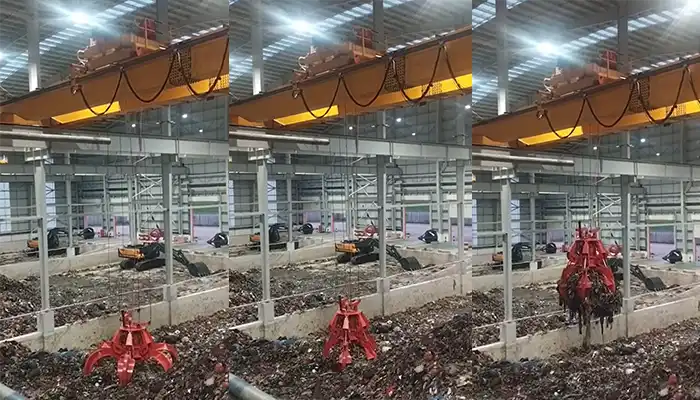
Supplied three grab bucket crane kits to Indonesia, enhancing garbage handling efficiency with high load capacity and reliable performance.
Free consultation to Confirm Parameters & Specifications and Get
Latest Crane Price & Crane Rate.
- Types of overhead cranes : _______?
- Optional: Overhead travelling crane, goliath gantry crane,Slewing jib crane, Single girder or double girder crane,small portable crane or kbk crane, etc.
- Capacity of overhead crane: _______?
- Optional: 0.25ton, 0.5 ton, 1 ton, 2 ton, 3ton, 5 ton, 10 ton,15ton, 20ton, 25 ton, 30ton,35ton, up to 550ton, etc.
- Crane span & lifting height : _______?
- Crane travelling length : _____?
- Control of overhead crane:_______?
- Optional: pendant/ remote/cabin control
- Voltage supply of overhead crane:_____?
- Eg,: 380V50/60HZ,3Phase or others,etc.
- Application/usage of crane:_______?
- Eg,: Steel mill, ,injection mold, cement,stone, concrete,granite, general manufacturing, etc.
Just leave a message via the contact form and our hoist and crane engineer will contact you with in 24working hours.
Get In Touch
